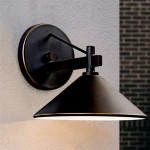PIR Lights: Enhancing Outdoor Security and Efficiency
Passive Infrared (PIR) lights are increasingly prevalent in outdoor settings due to their energy efficiency, security advantages, and overall convenience. These lights utilize PIR sensors to detect infrared radiation, specifically heat signatures emitted by moving objects, triggering illumination only when necessary. Understanding how PIR lights operate, their diverse applications, and the key factors influencing their performance is crucial for making informed decisions regarding their implementation in residential, commercial, and public spaces.
A PIR sensor, the core component of a PIR light, detects changes in infrared radiation levels within its field of view. All objects with a temperature above absolute zero emit infrared radiation. A PIR sensor contains two pyroelectric sensors which are sensitive to infrared energy. These sensors are arranged in such a way that, in a resting state, they receive the same amount of infrared radiation and create a balanced output. When a warm object, such as a person or vehicle, enters the sensor's field of view, it disrupts this balance, causing one sensor to detect more infrared radiation than the other. This difference generates a tiny electrical signal, which is then amplified and processed by the sensor's circuitry. If the signal meets a predefined threshold, the sensor triggers the light to activate.
The lens covering the PIR sensor plays a significant role in focusing infrared radiation onto the pyroelectric sensors. These lenses are typically made of Fresnel plastic, which is designed to divide the sensor's field of view into multiple detection zones. This segmentation enhances the sensor's ability to detect movement by creating specific areas of sensitivity. When an object moves across these zones, it triggers the sensor more reliably than if the field of view were a single, continuous area. The design and quality of the lens significantly impact the range and sensitivity of the PIR sensor.
PIR lights offer significant advantages in terms of energy conservation. By only activating when motion is detected, they avoid the constant energy consumption associated with traditional lights that remain on throughout the night. This contributes to lower electricity bills and reduces the overall environmental impact. The lifespan of the light source, commonly LED in modern PIR lights, is also extended due to reduced operating hours. This leads to less frequent replacements and further reduces waste.
Beyond energy savings, PIR lights significantly enhance security. The sudden illumination triggered by motion can deter potential intruders and alert residents or security personnel to activity in the area. This is particularly beneficial in areas prone to crime or vandalism, such as driveways, backyards, and building entrances. The presence of PIR lights can also create a sense of security and peace of mind for residents, knowing that their property is being monitored.
The applications of PIR lights are diverse, ranging from residential security to commercial and industrial settings. In residential homes, they are commonly used to illuminate driveways, walkways, and gardens. In commercial buildings, they are often installed in parking lots, loading docks, and around building perimeters. Industrial facilities use PIR lights to monitor access points, storage areas, and other sensitive locations. Public spaces, such as parks and recreational areas, also benefit from the security and energy efficiency provided by PIR lights.
Optimizing PIR Light Placement for Effective Detection
The placement of a PIR light is critical for maximizing its effectiveness. Obstructions, such as trees, bushes, or walls, can block the sensor's field of view and limit its ability to detect motion. Conversely, placing the light in an area with excessive movement, such as near a busy street, can lead to frequent and unnecessary activation. Optimal placement involves considering the desired area of coverage, potential obstructions, and the level of activity in the surrounding environment.
Typically, a PIR light should be mounted at a height that provides a wide field of view while minimizing the risk of false triggers. A height of approximately 6 to 10 feet is generally recommended, but this may vary depending on the specific model and the intended application. The angle of the sensor can also be adjusted to fine-tune the detection area. Some PIR lights offer adjustable sensitivity settings, allowing users to customize the sensor's response to different types of movement.
Consider the direction of approach when choosing a location. Installing a PIR light to detect movement perpendicular to the sensor's field of view is generally more effective than detecting movement directly towards or away from the sensor. This is because the changing infrared signature is more easily detected when an object is moving across the detection zones. It is also important to consider the potential for sunlight or reflections to trigger the sensor. Direct sunlight can sometimes cause false activations, so positioning the light away from direct sunlight exposure is advisable.
In addition to physical placement, the surrounding environment can also impact the performance of a PIR light. Areas with high levels of heat, such as near air conditioning units or vents, can interfere with the sensor's ability to detect human movement. Similarly, areas with excessive wind can cause swaying objects, such as trees or flags, to trigger the sensor. Taking these factors into account when selecting a location will help ensure that the PIR light operates effectively and reliably.
Understanding PIR Light Settings and Adjustments
Most PIR lights offer adjustable settings that allow users to customize their operation according to their specific needs. These settings typically include sensitivity, time duration, and light intensity. Understanding how to adjust these settings is crucial for optimizing the performance and energy efficiency of the PIR light.
The sensitivity setting determines the range at which the sensor will detect motion. A higher sensitivity setting will allow the sensor to detect movement at a greater distance, while a lower setting will limit the detection range. The appropriate sensitivity setting will depend on the size of the area to be monitored and the level of activity in the surrounding environment. In areas with frequent activity, a lower sensitivity setting may be necessary to prevent false triggers. Conversely, in areas with limited activity, a higher sensitivity setting may be desirable to ensure that all movement is detected.
The time duration setting determines how long the light will remain illuminated after motion is detected. A shorter time duration will conserve energy, but may not provide sufficient illumination for extended periods of activity. A longer time duration will provide extended illumination, but will also consume more energy. The appropriate time duration setting will depend on the intended use of the light and the level of activity in the area. For example, a shorter time duration may be suitable for illuminating a walkway, while a longer time duration may be necessary for monitoring a parking lot.
Some PIR lights also offer adjustable light intensity settings, allowing users to customize the brightness of the light. A higher light intensity will provide greater visibility, but will also consume more energy. A lower light intensity will conserve energy, but may not provide sufficient illumination in all situations. The appropriate light intensity setting will depend on the specific application and the desired level of illumination. Some PIR lights offer dimming capabilities, allowing the light to operate at a lower intensity until motion is detected, at which point it will automatically increase to full brightness.
Troubleshooting Common PIR Light Issues
PIR lights, like any electronic device, can experience issues that may affect their performance. Common problems include false triggers, failure to detect motion, and intermittent operation. Understanding the potential causes of these issues and how to troubleshoot them is essential for maintaining the functionality of the PIR light.
False triggers, where the light activates without any apparent motion, can be caused by a variety of factors. As previously mentioned, direct sunlight or reflections, high levels of heat, or excessive wind can all trigger the sensor. Additionally, insects or small animals can sometimes trigger the sensor, particularly if the sensitivity is set too high. To address this, try adjusting the sensitivity setting, repositioning the light away from direct sunlight or heat sources, and ensuring that the area around the sensor is clear of obstructions.
Failure to detect motion can be caused by a blocked field of view, a low sensitivity setting, or a faulty sensor. Ensure that there are no obstructions blocking the sensor's field of view and that the sensitivity setting is appropriately adjusted. If the problem persists, try testing the sensor by waving your hand in front of it at various distances and angles. If the sensor consistently fails to detect motion, it may be necessary to replace the sensor or the entire PIR light.
Intermittent operation, where the light works sporadically, can be caused by loose wiring, a faulty power supply, or a malfunctioning sensor. Check the wiring connections to ensure that they are secure and that there are no signs of damage. If the light is powered by batteries, ensure that they are fully charged and properly installed. If the problem persists, it may be necessary to consult with a qualified electrician to diagnose and repair the issue. Regularly cleaning the sensor lens can also prevent intermittent operation caused by dust or debris accumulation.

Auraglow Pir Motion Sensor Up Down Outdoor Wall Security Light Warminster Stainless Steel Led Lighting

Auraglow Pir Motion Sensor Stainless Steel Up Down Outdoor Wall Security Light Warminster Black Led Lighting

Astrid Outdoor Wall Light With Pir Sensor Anthracite Litecraft

Auraglow Black Arch Integrated Led Motion Sensor Pir Outdoor Wall Light Adobe Lighting

Asher Outdoor Wall Light With Pir Sensor Stainless Steel Bhs

Edit Optic Outdoor Wall Light With Pir Sensor Black Lighting Direct

Modern Stainless Steel Outdoor Light With Pir Sensor 6211

Up And Down Pir Motion Sensor Wall Light For Outdoor Use

Auraglow Dusk Till Dawn Daylight Pir Motion Detection Sensor Outdoor Wall Light Wharton Dorton Silver Led Lighting

Billy Outdoor Pir Sensor Wall Light Dunelm
Related Posts







